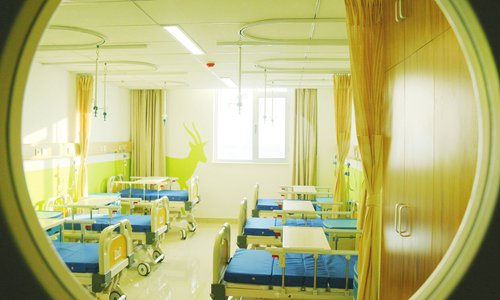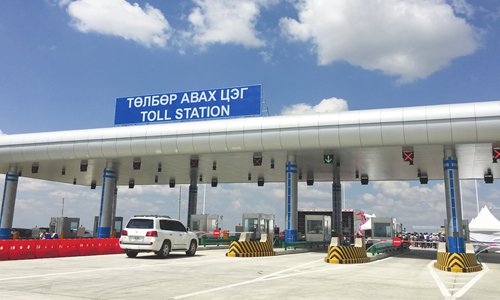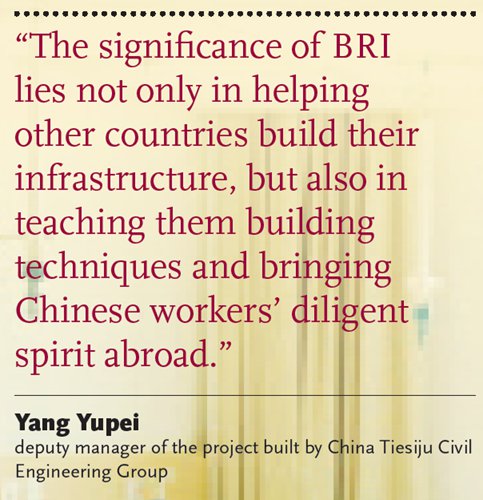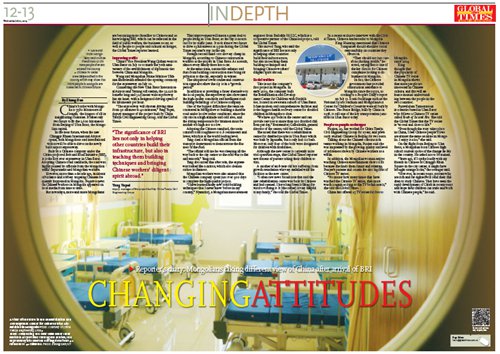HOME >> CHINA
Reporter’s diary: Mongolians taking different view of China after arrival of BRI
By Zhang Dan Source:Global Times Published: 2019/7/16 18:54:52
○ More and more Mongolians tend to show friendliness to Chinese people after BRI entered the country
○ Chinese TV series are widely watched in the country, which may show that more people in Mongolia are interested in Chinese culture

China's border with Mongolia is 7,580 kilometers in length, the longest of all its neighboring countries. It takes only two hours to fly the 1,600 kilometers from Beijing to Ulan Bator, the Mongolian capital.
In the near future, when the new Chinggis Khaan International Airport opens, both Mongolians and international visitors will be able to drive on the newly built airport expressway.
Built by a Chinese company under the China-proposed Belt and Road Initiative (BRI), it is the first ever expressway in Ulan Bator. Adopting Chinese road standards, the road was highly praised by officials from the Mongolian traffic department and Mongolian workers.
However, more than a decade ago, incidents of violence and robbery targeting Chinese frequently happened in Mongolia. Negative news on Chinese workers in Mongolia appeared on local media from time to time.
But nowadays, more and more Mongolians are becoming more friendlier to Chinese and acknowledging BRI, which can be reflected in the field of public welfare, the business sector, as well as people-to-people and cultural exchanges, the Global Times reporter learned.
Improving traffic
China's Vice President Wang Qishan went to Ulan Bator on July 10 to mark the 70th anniversary of the establishment of diplomatic ties between China and Mongolia.
Wang and Mongolian Prime Minister Ukhnaa Khurelsukh attended the opening ceremony for the expressway on July 10.
Connecting the New Ulan Bator International Airport and Yarmag toll station, the 32.226-kilometer long and 32.5-meter wide expressway has six lanes, with a designated driving speed of 80 kilometers per hour.
"The expressway will shorten driving time from 90 minutes to 40 minutes," Yang Yupei, deputy manager of the project built by China Tiesiju Civil Engineering Group, told the Global Times.
This improvement will mean a great deal to people living in Ulan Bator, as the city is notorious for its traffic jams. It took almost two hours to drive 19 kilometers at 9 pm during the Global Times reporter's stay in the city.
Foreign second-hand cars are very cheap in Mongolia, according to Chinese construction workers at the project in Ulan Bator. As a result, almost every family there has a car.
At the same time, automobile exhaust and dust from building construction sites bring air pollution to the city, especially in winter.
The ubiquitous tower cranes and construction signs also show the city is in a "growth period."
In addition to providing a faster alternative to the local people, the expressway also showcased the high-quality standards and intelligent road-building technology of a Chinese company.
One of the biggest difficulties the team encountered in Mongolia was building a durable road under local weather conditions, since the city sits in a high altitude and cold area, and the drying temperature for bitumen must be neither too high nor too low.
Adopting the Chinese standard, the team controls road roughness to 0.8 centimeters and lower, which is at the world-leading level.
Yang cited a Mongolian official from the transport department to demonstrate the flatness of the road.
"The official told me he was sleeping all the way back to the city center as the road was so flat and smooth," Yang said.
Yang also noted that after rain, the expressway looked like a mirror, which also demonstrates its flatness.
Mongolian workers were also amazed that the Chinese company spent just over 900 days to complete the high-quality project.
"I have learned many new road-building techniques that I never knew before in my country," Nyamdorj, a Mongolian measurement engineer from Badrakh-Oil LLC, which is a cooperative partner of the China-led project, told the Global Times.
This moved Yang, who said the significance of BRI lies not only in helping other countries build their infrastructure, but also in teaching them building techniques and bringing Chinese workers' diligent spirit abroad.

This is not the company's first project in Mongolia. In early 2019, the company built the Rehabilitation and Development Center for Children with Disabilities, located in a western suburb of Ulan Bator. It has modern and comprehensive facilities and is the biggest health recovery center for disabled children in Mongolia to date.
"We have 250 beds in the center and can provide services to more than 500 disabled children per day," Rentsendorj Galbadrakh, general director of the center, told the Global Times.
She noted that there was a rehabilitation center for disabled people in Ulan Bator which was built by Japanese, but it only had 60 beds. Moreover, only four of the beds were designated for children with disabilities.
Although the new center is currently in its trial operation stage, this Global Times reporter saw dozens of parents taking their children to visit.
A mother of an 8-year-old boy suffering from growth retardation was very satisfied with the facilities at the new center.
"I often saw news broadcasts that said the new rehabilitation center was built by Chinese and had opened. I have long been looking forward to visiting it. It [the center] is very helpful to my family," she told the Global Times.
In a recent exclusive interview with the Global Times, Chinese Ambassador to Mongolia Xing Haiming mentioned that Chinese companies should shoulder social responsibility in countries they invest in.
"They should not just care about making profits," he noted, saying that is one of the key factors for Chinese companies looking to do business in Mongolia.
In fact, the Chinese government has provided construction assistance to Mongolia since the 1950s, according to a People's Daily's report on July 11. Iconic buildings such as the National Sports Stadium and Mongolian Art Center for Children's Creativity were all built by Chinese. The Peace Bridge, built by China in 1958, is still one of the key transportation junctions in Ulan Bator today.

Puujee, 29, has worked for China Tiesiju Civil Engineering Group for a year, and previously studied Chinese in Beijing for two years.
Talking about the Chinese construction teams working in Mongolia, Puujee said she was impressed by the growing quality and level of politeness shown by Chinese workers as a whole.
In addition, the Mongolian woman enjoys watching Chinese entertainment shows a lot because she finds them funny and relaxing. Puujee's parents and cousin are also big fans of Chinese TV series.
"No matter how many times they have watched the Chinese TV series, they must watch it again as long as the TV broadcasts it," she told the Global Times.
China has offered 25 TV series for free to Mongolia since 2014.
Xing thought that the popularity of Chinese TV series in Mongolia shows that more people are interested in Chinese culture, and this will enhance mutual understanding between the people in the two countries.
Purevdulam Tumennasan is a dentist based in Ulan Bator who follows a Chinese TV series called Youth of Ice and Fire. She told the Global Times that the TV series is "so real and close to life."
"Even though the story takes place in China, I feel Chinese people's lives are almost the same as mine in Mongolia. I enjoy it a lot," she said.
On the flight from Beijing to Ulan Bator, a Mongolian-born Chinese high school student spoke of the change he felt in the country. He asked not to be named.
"Years ago, if I spoke loudly with my friends in Chinese at Chinggis Khan Square in the city center, it might have brought strange looks," the teenager said.
"However, in recent years, parents who are rich and far-sighted will send their children to study Chinese. They have seen the rapid development of China in recent years and hope their children can trade and work with Chinese people," he said.

Newspaper headline: Changing attitudes
○ Chinese TV series are widely watched in the country, which may show that more people in Mongolia are interested in Chinese culture

A view of the ward in the Rehabilitation and Development Center for Children with Disabilities in Mongolia Photo: Courtesy of China Tiesiju Engineering Group
China's border with Mongolia is 7,580 kilometers in length, the longest of all its neighboring countries. It takes only two hours to fly the 1,600 kilometers from Beijing to Ulan Bator, the Mongolian capital.
In the near future, when the new Chinggis Khaan International Airport opens, both Mongolians and international visitors will be able to drive on the newly built airport expressway.
Built by a Chinese company under the China-proposed Belt and Road Initiative (BRI), it is the first ever expressway in Ulan Bator. Adopting Chinese road standards, the road was highly praised by officials from the Mongolian traffic department and Mongolian workers.
However, more than a decade ago, incidents of violence and robbery targeting Chinese frequently happened in Mongolia. Negative news on Chinese workers in Mongolia appeared on local media from time to time.
But nowadays, more and more Mongolians are becoming more friendlier to Chinese and acknowledging BRI, which can be reflected in the field of public welfare, the business sector, as well as people-to-people and cultural exchanges, the Global Times reporter learned.
Improving traffic
China's Vice President Wang Qishan went to Ulan Bator on July 10 to mark the 70th anniversary of the establishment of diplomatic ties between China and Mongolia.
Wang and Mongolian Prime Minister Ukhnaa Khurelsukh attended the opening ceremony for the expressway on July 10.
Connecting the New Ulan Bator International Airport and Yarmag toll station, the 32.226-kilometer long and 32.5-meter wide expressway has six lanes, with a designated driving speed of 80 kilometers per hour.
"The expressway will shorten driving time from 90 minutes to 40 minutes," Yang Yupei, deputy manager of the project built by China Tiesiju Civil Engineering Group, told the Global Times.
This improvement will mean a great deal to people living in Ulan Bator, as the city is notorious for its traffic jams. It took almost two hours to drive 19 kilometers at 9 pm during the Global Times reporter's stay in the city.
Foreign second-hand cars are very cheap in Mongolia, according to Chinese construction workers at the project in Ulan Bator. As a result, almost every family there has a car.
At the same time, automobile exhaust and dust from building construction sites bring air pollution to the city, especially in winter.
The ubiquitous tower cranes and construction signs also show the city is in a "growth period."
In addition to providing a faster alternative to the local people, the expressway also showcased the high-quality standards and intelligent road-building technology of a Chinese company.
One of the biggest difficulties the team encountered in Mongolia was building a durable road under local weather conditions, since the city sits in a high altitude and cold area, and the drying temperature for bitumen must be neither too high nor too low.
Adopting the Chinese standard, the team controls road roughness to 0.8 centimeters and lower, which is at the world-leading level.
Yang cited a Mongolian official from the transport department to demonstrate the flatness of the road.
"The official told me he was sleeping all the way back to the city center as the road was so flat and smooth," Yang said.
Yang also noted that after rain, the expressway looked like a mirror, which also demonstrates its flatness.
Mongolian workers were also amazed that the Chinese company spent just over 900 days to complete the high-quality project.
"I have learned many new road-building techniques that I never knew before in my country," Nyamdorj, a Mongolian measurement engineer from Badrakh-Oil LLC, which is a cooperative partner of the China-led project, told the Global Times.
This moved Yang, who said the significance of BRI lies not only in helping other countries build their infrastructure, but also in teaching them building techniques and bringing Chinese workers' diligent spirit abroad.

Connecting the New Ulan Bator International Airport and Yarmag toll station, the expressway will shorten driving time from 90 minutes to 40 minutes. Photo: Zhang Dan/GT
Social welfareThis is not the company's first project in Mongolia. In early 2019, the company built the Rehabilitation and Development Center for Children with Disabilities, located in a western suburb of Ulan Bator. It has modern and comprehensive facilities and is the biggest health recovery center for disabled children in Mongolia to date.
"We have 250 beds in the center and can provide services to more than 500 disabled children per day," Rentsendorj Galbadrakh, general director of the center, told the Global Times.
She noted that there was a rehabilitation center for disabled people in Ulan Bator which was built by Japanese, but it only had 60 beds. Moreover, only four of the beds were designated for children with disabilities.
Although the new center is currently in its trial operation stage, this Global Times reporter saw dozens of parents taking their children to visit.
A mother of an 8-year-old boy suffering from growth retardation was very satisfied with the facilities at the new center.
"I often saw news broadcasts that said the new rehabilitation center was built by Chinese and had opened. I have long been looking forward to visiting it. It [the center] is very helpful to my family," she told the Global Times.
In a recent exclusive interview with the Global Times, Chinese Ambassador to Mongolia Xing Haiming mentioned that Chinese companies should shoulder social responsibility in countries they invest in.
"They should not just care about making profits," he noted, saying that is one of the key factors for Chinese companies looking to do business in Mongolia.
In fact, the Chinese government has provided construction assistance to Mongolia since the 1950s, according to a People's Daily's report on July 11. Iconic buildings such as the National Sports Stadium and Mongolian Art Center for Children's Creativity were all built by Chinese. The Peace Bridge, built by China in 1958, is still one of the key transportation junctions in Ulan Bator today.

People-to-people exchanges
Puujee, 29, has worked for China Tiesiju Civil Engineering Group for a year, and previously studied Chinese in Beijing for two years.
Talking about the Chinese construction teams working in Mongolia, Puujee said she was impressed by the growing quality and level of politeness shown by Chinese workers as a whole.
In addition, the Mongolian woman enjoys watching Chinese entertainment shows a lot because she finds them funny and relaxing. Puujee's parents and cousin are also big fans of Chinese TV series.
"No matter how many times they have watched the Chinese TV series, they must watch it again as long as the TV broadcasts it," she told the Global Times.
China has offered 25 TV series for free to Mongolia since 2014.
Xing thought that the popularity of Chinese TV series in Mongolia shows that more people are interested in Chinese culture, and this will enhance mutual understanding between the people in the two countries.
Purevdulam Tumennasan is a dentist based in Ulan Bator who follows a Chinese TV series called Youth of Ice and Fire. She told the Global Times that the TV series is "so real and close to life."
"Even though the story takes place in China, I feel Chinese people's lives are almost the same as mine in Mongolia. I enjoy it a lot," she said.
On the flight from Beijing to Ulan Bator, a Mongolian-born Chinese high school student spoke of the change he felt in the country. He asked not to be named.
"Years ago, if I spoke loudly with my friends in Chinese at Chinggis Khan Square in the city center, it might have brought strange looks," the teenager said.
"However, in recent years, parents who are rich and far-sighted will send their children to study Chinese. They have seen the rapid development of China in recent years and hope their children can trade and work with Chinese people," he said.

Newspaper headline: Changing attitudes
Posted in: IN-DEPTH